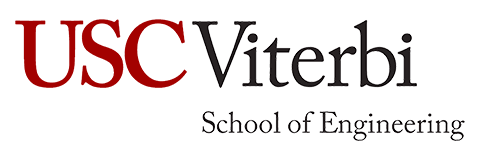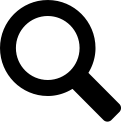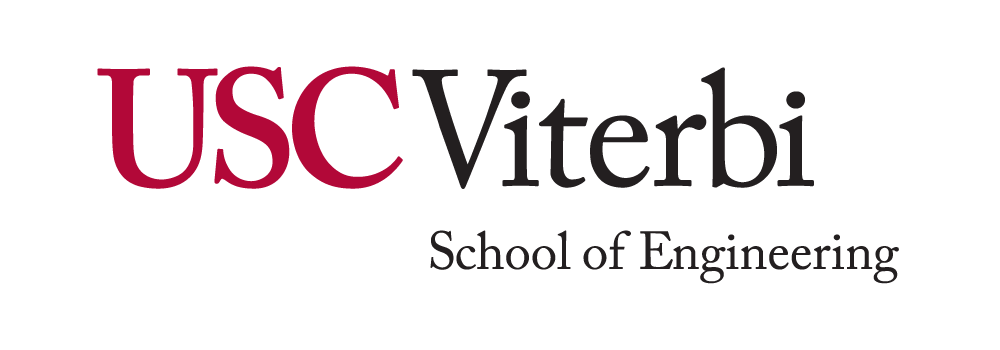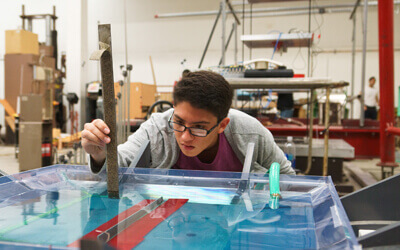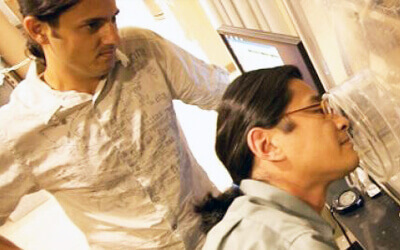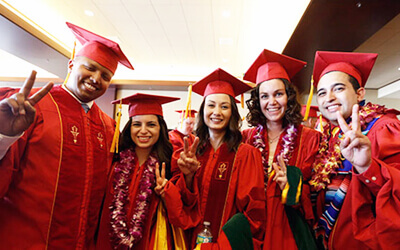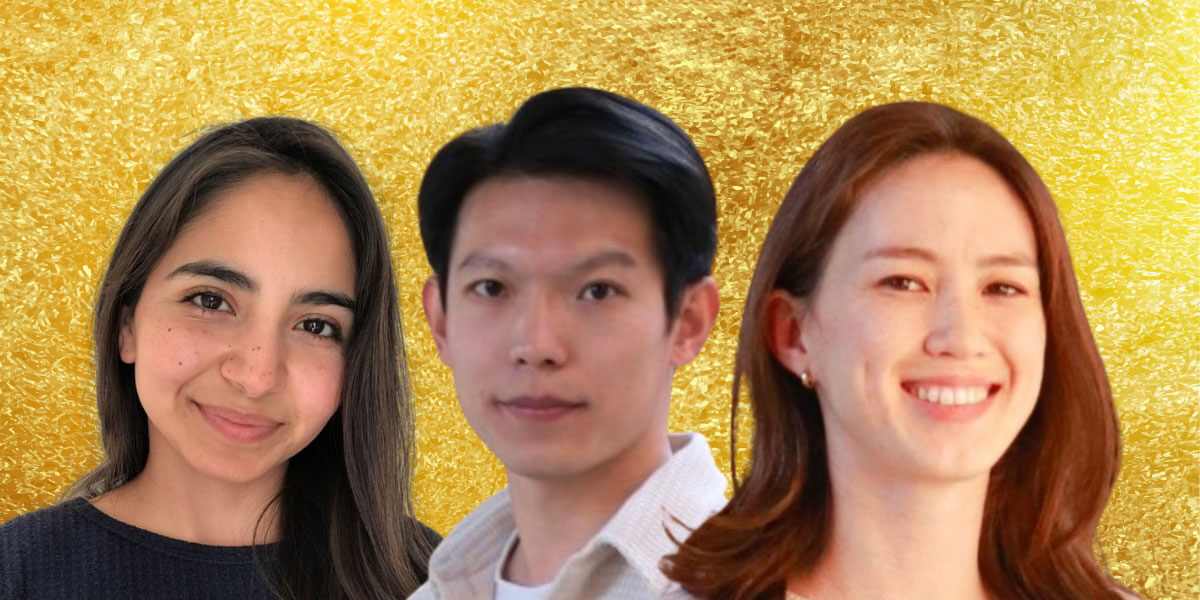
Astani Graduate Scholars Venezia Ramirez, Hang Wu and Lisa Staugaard
From chronic air pollution in cities, to the presence of PFAS in our drinking water, to the toxicity of food disinfecting processes… Sometimes, just getting through the day can feel like navigating a series of environmental hazards.
With the support of the Astani Graduate Scholars Program, a new generation of master’s students at USC Sonny Astani Department of Civil & Environmental Engineering are tackling those problems head on.
Hang Wu focuses on per- and polyfluoroalkyl substances (PFAS) contamination in urban environments. Advised by Associate Professor Adam Smith, Wu’s research has characterized PFAS presence and distribution in drinking water across Southeast Los Angeles.
Advised by Assistant Professor Adam Simpson, Lisa Staugaard’s research examines the formation of toxic byproducts generated during the aesthetic bleaching of tree nuts, an overlooked yet critical issue at the intersection of food production, water safety and human health.
Investigating the interactions of air quality, climate, and society, Venezia Ramirez’s work integrates sustainability with environmental justice and equity, quantifying disparities in vehicle miles traveled (VMT) and diesel truck emissions across disadvantaged communities. She is advised by Assistant Professor Jiachen Zhang.
We caught up with the three scholars to learn more about their commitment to advancing environmental sustainability.
Hang Wu
Building on his investigation of PFAS presence and distribution in drinking water across Southeast Los Angeles, Wu has developed novel protocols for PFAS extraction from household dust, providing critical insights into indoor exposure pathways. 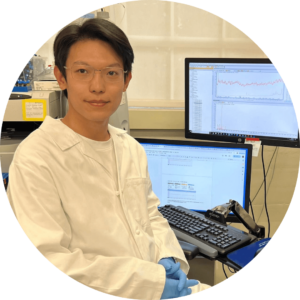
Why are PFAS such a major problem?
HW: These chemicals are extremely persistent and have now been detected in water, household dust and even ambient air. The key challenge is that PFAS are very difficult to break down and can build up in the body leading to health concerns such as cancer, hormone disruption and developmental effects.
My research focuses on evaluating PFAS across drinking water, indoor dust and the atmosphere, which are the most significant exposure pathways for humans. By building a comprehensive understanding of their distribution and transport, we can design solutions that mitigate the risk for public health.
Where do you see the opportunities to innovate and make an impact?
HW: Innovation in this field includes the development of effective extraction techniques, more sensitive detection methods, the advancement of treatment technologies (including degradation and removal, such as advanced oxidation/reduction and reverse osmosis), and the integration of these tools into scalable, sustainable systems.
The broader impact of this work is substantial: ensuring access to safe drinking water, reducing chronic human exposures and supporting sustainable practices such as potable water reuse. PFAS research demonstrates how engineering can turn environmental challenges into opportunities for lasting progress.
What first inspired your interest in this area of engineering for sustainability?
HW: My commitment to sustainability was originally motivated by coal-related air and water pollution in my hometown of Taiyuan in Shanxi Province, China. Witnessing the impact of industrial contamination on both the environment and human health inspired me to pursue environmental engineering.
During my undergraduate studies at the University of Shanghai for Science and Technology, I gained my first research experience in wastewater treatment by modifying biomass ash to recycle waste into useful treatment media. This project gave me my early insight into how engineering solutions could simultaneously address environmental pollution and repurpose waste materials, which strengthened my determination to continue pursuing sustainable environmental engineering. Later, through my master’s training at Syracuse University and work in sustainable consulting, I learned that sustainability can also create economic value for businesses by optimizing product design and strategically choosing recycled materials.
How would you define “sustainability” and how can we each shape our actions to contribute to planetary and social sustainability?
HW: I define sustainability in three dimensions. First, it means proactively building sustainable lifestyles, production models and consumption patterns that minimize harm to the environment and human well-being. Second, it involves improving the ways we currently live, produce and consume. In addition, it requires addressing unsustainable practices that have already caused damage by applying advanced technologies and management strategies to remediate, repair and guide the transition toward long-term sustainability.
At the personal level, contributing to sustainability begins with cultivating responsible habits, such as reducing the use of single-use products, recycling properly and reusing resources. For those aspiring to become future leaders or entrepreneurs, it is crucial to design, produce and manage products with a careful balance between economic benefit and sustainability, while continuously seeking innovative technologies that drive this balance toward a more sustainable future.
What challenges have you faced during your education and career to date, and what has helped you move through them?
HW: One challenge I have faced in my research is the difficulty of accurately detecting PFAS in complex samples such as dust, where interferences often affect analysis. To address this, I have tested various cleanup methods, studied approaches reported in the literature, and collaborated with peers to refine protocols. These experiences taught me persistence, adaptability and the importance of teamwork in addressing emerging challenges in science and society.
The skills I gained in handling complex samples, applying advanced analytical tools (such as LC-MS, Liquid Chromatography- Mass Spectrometry) and interpreting PFAS data have equipped me to effectively handle other complex environmental problems. More importantly, through overcoming the challenges encountered in this project, I learned how to think systematically and deeply about complex problems, breaking them down and solving them step by step in an organized way. This ability has laid a solid foundation for me to approach future challenges in both life and work with independence and efficiency.
In the long term, I hope to translate these solutions into practical technologies and products that can be implemented on a broader scale. My vision is that communities will directly benefit from this research, gaining access to cleaner water, healthier environments and sustainable systems that reduce the risks associated with PFAS.
Lisa Staugaard
As part of the Simpson Lab at USC, Staugaard’s research focuses on food matrix manipulation techniques to measure contaminants within the macromolecular structure of food. She is extending this work through an industry internship with Trussell Technologies, advancing California’s water reuse and treatment practices.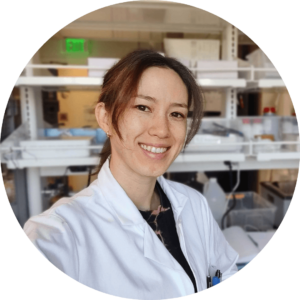
What intrigues you about the engineering problems of food and water contamination?
LS: I’m fascinated by how engineered materials interact with the natural world, particularly how water quality affects our built environment and food systems. In Los Angeles, most of our water is imported from hundreds of miles away, used, then discharged into the ocean. With challenges such as water contamination and infrastructure deterioration, it is more important than ever to recycle water locally. I’m fortunate to work alongside engineers developing solutions to address this excessive waste.
In the Simpson Lab, we view food itself as an “engineered material” because of the immense scale, design, and processing required to support modern society. We study how the quality of water used to grow and wash food can both introduce and prevent contaminants. For example, disinfection can create toxic byproducts, but we rely on it to reduce pathogens that cause foodborne illness. Our innovative methods can measure food-disinfection byproducts at various disinfectant dosages, providing evidence to improve industry-specific processes that can have a direct impact on public health.
What first inspired your interest in this area of engineering?
LS: My interest in environmental engineering began with chemistry. Understanding the physical world in terms of elements and molecules naturally led me to wonder how contaminants move through water, soil and even food. During my undergraduate studies, working one summer turning over university apartments, I learned to refinish their solid wood furniture and manage discarded belongings, making them available to new students for free. That experience inspired me to launch Iridium Interiors in 2015, an online business where restoration and sustainability could make a tangible difference in the local community.
Sustainability is the driving force behind designs that harmonize with nature and ensure long-term resilience. When I discovered that environmental engineering is a field that unites chemistry, sustainability and real-world impact, I knew I had found my path.
How would you define “sustainability” and how can we each shape our actions to contribute to planetary and social sustainability?
LS: To me, sustainability means understanding the long-term consequences of convenience. It means understanding the end-of-life of materials and how they degrade in order to drive better decisions. For example, when I shop, I consider the packaging, shipping distance, brand values and the resale value. Most household goods I buy are second-hand, which reduces packaging waste, cuts cost and strengthens the local community. I believe each of us can contribute to sustainability by slowing down our buying decisions. Giving ourselves time to be deliberate can reveal that many purchases are not needed – or, that more creative and sustainable solutions are possible.
What is your area of focus in your graduate research at USC, and in what ways has your previous experience informed your research?
LS: My background in failure analysis and corrosion trained me to detect and interpret trace elements using tools like scanning electron microscopy with an x-ray detection (SEM/EDX). In particular, I learned how chloride ions act as catalysts for corrosion – skills that directly translate to my current graduate research at USC. In the Simpson Lab, I study the water-food nexus by synthetically digesting food to isolate fats and proteins, then identifying chlorinated byproducts within food. This work helps reveal how water treatment practices affect food safety and nutritional quality, contributing to improved sustainable and health-protective processes.
What are your goals for your current research, and what impact do you hope your work will achieve both in the short and the long term?
LS: My broad goal is to generate new knowledge that can improve the food and water systems that millions of people rely on. By studying how disinfection affects food safety and nutrition, I hope to provide data that informs safer, more sustainable industry practices. In the short term, I’m focused on sharpening my ability to communicate complex science clearly to non-academic audiences, so that my work can be understood and applied beyond the lab. I also want to empower my peers and community to make more deliberate, sustainable choices, since many people who want to be eco-conscious lack accessible information. Ultimately, I hope my research and outreach can drive systemic and individual action toward sustainability.
Venezia Ramirez
Ramirez’s research reflects a commitment to building tools that address both technical and social dimensions of environmental inequity. Investigating disparities in vehicle miles traveled (VMT) and diesel truck emissions across disadvantaged communities, she is highlighting the limitations of existing inequity metrics and presenting a case for neighborhood-scale air quality monitoring.
How would you define “sustainability” and how can we each shape our actions to contribute to planetary and social sustainability?
VR: Sustainability isn’t just maintaining our consumption of natural resources at a lower rate than the rate of replenishment, but acknowledging that our natural resources are our relationships to the land. When we recognize our relationships to our environment, we understand the importance of protecting these relationships just as we protect our relationships with one another.
How does that outlook inform your approach to research?
VR: Working with Assistant Professor Jiachen Zhang, I have summarized literature on quantitative analysis and data visualization methods to assess inequities in truck emissions across disadvantaged communities.
My focus was on gathering key metrics – such as figures, tables and maps – that illustrate racial disparities in pollution burden and the potential health benefits of emission reduction scenarios. Now I am researching current methods to measure magnitude of PFAS emissions to understand the fate and transport of PFAS emitted from local place-based hazards.
My air quality research helped me secure a summer internship at the NASA Ames Research Center where I utilized GIS (Geographic Information System) to co-develop a global open-access database of low-cost air quality sensor networks. Incorporating my experience of being a community leader, I focused on developing optimal methods for data visualization within the platform to facilitate user experience regardless of technical or financial resources.
Next, I aim to join the USC Superfund Research and Training Program for PFAS Assessment, Remediation and Prevention (ShARP) to study cross-media PFAS contamination, with a focus on groundwater.
What challenges have you faced during your education and career to date, and what has helped you move through them?
VR: I never dreamed that I would attend the institution where my parents met as cleaning staff. As a first-generation college graduate, the daughter of Mexican immigrants from a low-income household, and a woman of color in the early career stages, it has been difficult to connect with other researchers who do not understand the urgency of implementing engineering solutions within our communities. It is a constant battle to validate why resources such as air monitors, water testing kits and soil sampling, open-access data, need to be allocated to our communities that are under-resourced, over-exploited and disproportionately burdened by environmental contamination.
During my undergraduate and graduate studies, my family and I experienced severe financial adversities. The pressure from my home situation was crippling to my education. I thought of withdrawing from the university many times. Ultimately, however, I chose to continue my education due to my devotion to use open-access environmental data to alleviate the environmental burdens that disproportionately impact our communities.
What does it mean to you to address environmental issues through engineering solutions co-created by the community, for the community?
VR: A recent experience made me realize my capacity to create change using environmental data. When I learned of a city proposal to develop a last-mile delivery facility (the last stop of semi-trailer trucks before delivery of parcels) in my neighborhood, I feared the reduced air quality and adverse health impacts it would cause for my family and neighbors.
The resident-led community group I co-founded, Norwalk Unides, provided the space for me to read the environmental impact report of the proposal, investigate potential health impacts from high exposure to diesel emissions, communicate pollution burden data from CalEnviroScreen 4.0 in an accessible format in resident-led spaces, canvass in my neighborhood to gather signatures against the development, and facilitate resident participation in the city planning commission meetings.
Through our efforts, we successfully prevented the last-mile delivery facility from being developed 330 meters from my home and prevented the zoning code proposal that would have allowed the zoning in Norwalk, CA to allow for similar developments. By applying my knowledge and skills to reduce the environmental exposures that impact quality of life, I realized my capacity could be increased with the technical skills of a master’s degree in sustainable engineering from CEE.
If the stories of these scholars resonate with your own experience, you might like to take a look at CEE master’s degrees, or even apply to be an Astani Graduate Scholar here.
Published on October 22nd, 2025
Last updated on October 23rd, 2025
